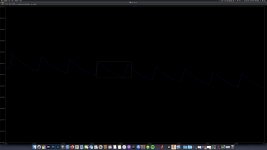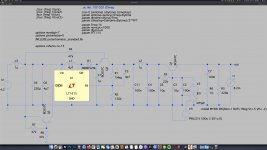For years I've been playing a guitar with active EMG pickups and active tone controls. About a month ago I decided to rebuild the guitar in a more genuine Stratocaster fashion. This means also having a pickguard, which the old one didn't have.
Now EMG's normally are powered by 9 or 18V from one or two 9V batteries. As the body I use isn't utilised with a dedicated battery compartment, I opted to experiment a bit with a Li-ion cell and a charger and an asynchronous boost converter (on the same board). I do not have room for 2 batteries anymore. Also, being able to charge via USB is hugely convenient, even with the long battery life with EMG equipment. Just charge before a gig and you're safe.
The charger is a TC4056a, the converter is based on a SDB628. The results were rather disappointing, even for stuff from aliexpress. There is a pretty big hiss and a bit of hum present in the output signal of the pickups. I added a not so well calculated LC filter after the converter and got slightly better results.
Obviously, aliexpress might not have been the best bet for reliable and more than basic hardware in the first place. Are there safe and reliable options available to work with li-ion cells this way? For now I use a 9V battery with a charge pump. That is silent but not as convenient as I'd like. Suggestions are more than welcome.
Now EMG's normally are powered by 9 or 18V from one or two 9V batteries. As the body I use isn't utilised with a dedicated battery compartment, I opted to experiment a bit with a Li-ion cell and a charger and an asynchronous boost converter (on the same board). I do not have room for 2 batteries anymore. Also, being able to charge via USB is hugely convenient, even with the long battery life with EMG equipment. Just charge before a gig and you're safe.
The charger is a TC4056a, the converter is based on a SDB628. The results were rather disappointing, even for stuff from aliexpress. There is a pretty big hiss and a bit of hum present in the output signal of the pickups. I added a not so well calculated LC filter after the converter and got slightly better results.
Obviously, aliexpress might not have been the best bet for reliable and more than basic hardware in the first place. Are there safe and reliable options available to work with li-ion cells this way? For now I use a 9V battery with a charge pump. That is silent but not as convenient as I'd like. Suggestions are more than welcome.
With a strat you have the option to place one or even two 9V-battery blocks inside the vibrato spring compartment on the backside of the body. Just remove 2 springs. Any switching regulator with its magnetic stray field in the vicinity of high sensitive magnetic pickups is a call for trouble.
Thanks for the suggestions. EMG's are made for battery power, yes. But also up to 27V single supply though. It has got its use to operate EMG's on 2 9V cells though. Boost circuits like the PA or SPC will quickly run out of steam with a single 9V battery that is getting empty. To my ears 18V sounds a bit less compressed and more clear over 9V. Luckily the charge pump is very quiet. No difference from a 9V battery. Just need a solution to easily charge them without popping up the pickguard. Li-ion 9V cells are nominal 8.4V and drop a lot from thereon.
For the sake of this being a hobby, actually my favourite one: can you think of any switching supply like I mentioned that might be quiet enough? Or will EMI and switching artefacts always be a problem with sensitive equipment like guitar pickups?
For the sake of this being a hobby, actually my favourite one: can you think of any switching supply like I mentioned that might be quiet enough? Or will EMI and switching artefacts always be a problem with sensitive equipment like guitar pickups?
That is a problem, yes. |Not that efficiency is much of a design criterium to me, IF charging is easy. My guitar has 3 pickups, SA/SA/89. Current draw should be around 240uA @ 9V. More on 18V, but not sure how much (might be as little as 10% IIRC).
The SPC though draws almost 1mA @9V. The EXG is not much different. So that's almost 2mA when you've got both in a guitar and your pickups. That won't get you your 1000 hours of use on a single battery.
Im about to build my own version of the SPC. Those buggers are expensive! DIY is also more fun to me. With either a LF442 or TL062 current draw will be around 500uA.
Anyway, Fishmann sells battery packs that put out 9V from a LiPo pack. Boosting is done by a TPS6104 from TI. That chip is at least 80% efficient from 500uA up from a single Li-ion cell. There seems to be a lot of protection and extra filtering going on on the boards of the Fishmann system. Lots of transistors and no actual idea what they are doing from my side. I do not have the actual unit. There seems to be a second stage LC filter though: a tiny 0805 inductor and some big tantalums.
So, it can be done. The Fishmann packs work with EMG's, confirmed. At 9V though. The TI boost chip should be capable of much more.
The SPC though draws almost 1mA @9V. The EXG is not much different. So that's almost 2mA when you've got both in a guitar and your pickups. That won't get you your 1000 hours of use on a single battery.
Im about to build my own version of the SPC. Those buggers are expensive! DIY is also more fun to me. With either a LF442 or TL062 current draw will be around 500uA.
Anyway, Fishmann sells battery packs that put out 9V from a LiPo pack. Boosting is done by a TPS6104 from TI. That chip is at least 80% efficient from 500uA up from a single Li-ion cell. There seems to be a lot of protection and extra filtering going on on the boards of the Fishmann system. Lots of transistors and no actual idea what they are doing from my side. I do not have the actual unit. There seems to be a second stage LC filter though: a tiny 0805 inductor and some big tantalums.
So, it can be done. The Fishmann packs work with EMG's, confirmed. At 9V though. The TI boost chip should be capable of much more.
Here I am again. I did some more research into making a simple dc converter silent enough for active pickups. Fishman applies some tricks to their stuff. Those include extra input and output filtering with inductors, a cap multiplier, load disconnect, switching enable signal. The base of the input disconnect should be tied to the ring of a stereo input jack. When plugging in a mono jack, the transistor and thus the converter turns on.
So, does it work? Yes, it does. I did a test on a breadboard, a simple Ali converter and an output filter like in the attached schematic. The result? Dead silent, as in as silent as with a 9V battery. And this Ali converters hissed like mad before.
So, does it work? Yes, it does. I did a test on a breadboard, a simple Ali converter and an output filter like in the attached schematic. The result? Dead silent, as in as silent as with a 9V battery. And this Ali converters hissed like mad before.
Attachments
- Status
- This old topic is closed. If you want to reopen this topic, contact a moderator using the "Report Post" button.
- Home
- Amplifiers
- Power Supplies
- Li-ion charger and boost converter for active guitar pickups

